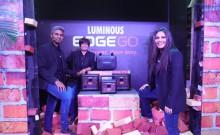A new device that uses wireless signals to identify human figures through walls is being developed by the science and Artificial Intelligence Lab of the Massachusetts Institute of Technology (MIT).
The new technology, called RF-Capture, "could trace a person's hand as he writes in the air. It could also distinguish between 15 different people through a wall with 90% accuracy," MIT announced on Wednesday.
How does the device work?
A video published by the MIT describes the device that can capture a human figure through the walls of a building. The device operates by transmitting wireless signals that traverse the wall, reflect off the human body and come back.
At every point of time, only one sub-set of the human body part reflects the signal back to the device. It then combines the snap shots and uses an algorithm to stitch together the sillehoute of the human.
The device placed behind the wall can also distinguish between people and human postures.
RF-capture constructs a human figure by using a compact array of 20 antennas, transmitting wire signals reflections, Ars Technica website reported.
The transmitted power is just 1/1,000 of what WiFi signals require to operate at a frequency lower than X-ray, tetrahertz or the millimetre-wave systems. This allows signals to penetrate walls, as reported by the website.
Figures of Accuracy levels
The RF-Capture can distinguish upto five human figures with 95.7% accuracy and 15 people with 88.2% accuracy level.
It could also identify the movement of a body part of an individual with 99.13% accuracy if the person is three metres away from the wall and 76.4% accuracy if the person is eight metres behind the wall, Ars Technica reported.
The RF-Capture could also track the palm of the user upto a few centimetres, tracing letters that the user writes in the air from behind a wall, researchers said. The RF-Capture could detect the body part with a median error of 2.19 centimetres, the report further stated.
Plans
In the near future, "the technology could be used as a home device. It could be used to operate the TV, use switches or possibly detect if a family member has fallen unconscious," said Dina Katabi, director of the wireless at the MIT centre.
The technology could have real-world applications; it could allow you to play a video game from a different room.
In movies, the RF-capture could assist in motion capture without requiring actors to wear body suits.
Limitations of RF-Capture
The model assumes that the subject always walks towards the device, which allows the device to capture consecutive RF snapshots which would reveal the body limbs, the researchers said.
Secondly, the system could not perform full skeletal tracking, because not all the body parts appeared in the RF snapshots, the researchers added.
Here is the video of the RF Capture device by MIT's computer science and Arificial Intelligence lab:

















